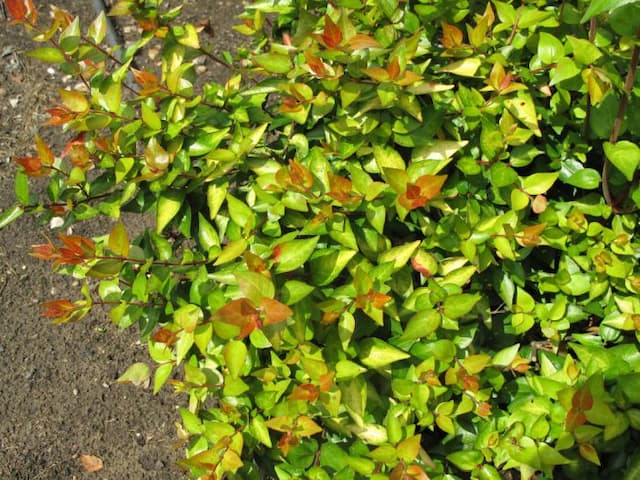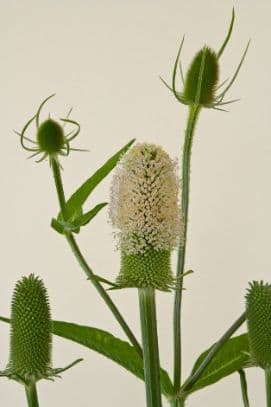Etruscan Honeysuckle Lonicera etrusca 'Donald Waterer'

ABOUT
The Lonicera etrusca 'Donald Waterer', commonly known as the Etruscan honeysuckle, is a deciduous or semi-evergreen climber that boasts a lush foliage paired with highly ornamental flowers. The leaves are oval-shaped with a blue-green hue and sometimes possess a slightly bluish or glaucous underside, providing an overall textured appearance to the vine. Come late spring to early summer, the Etruscan honeysuckle bursts into a profusion of fragrant blooms. The flowers are tubular with a flared, lip-like shape and display a striking two-tone color scheme—inside, a creamy white shade is juxtaposed with the outer petals' pink to deep rosy hues. These attractive blossoms give way to small, round berries that ripen to a translucent red or orange tone and are favored by birds and wildlife. The plant's stems twine and twist, giving it the ability to climb over structures, trellises, and fences. Its naturalistic charm and the gentle perfume of its flowers make it a delightful addition to any garden that seeks to elicit a cottage-style or romantic ambiance. Overall, the Etruscan honeysuckle, with its elegant foliage and alluring flowers, creates a vivid display that is both visually and aromatically pleasing.
About this plant
 Names
NamesFamily
Caprifoliaceae
Synonyms
Etruscan Honeysuckle, Italian Woodbine
Common names
Lonicera etrusca 'Donald Waterer'
 Toxicity
ToxicityTo humans
The Lonicera etrusca 'Donald Waterer', commonly known as the Etruscan honeysuckle, is not typically considered highly toxic to humans. However, many plants in the honeysuckle family have parts that can be mildly toxic if ingested in large quantities. Symptoms of ingesting parts of the plant can include stomach upset, nausea, vomiting, and diarrhea. Ingestion of honeysuckle berries can be potentially more toxic, especially to children, and could result in more severe symptoms. It is advisable to avoid consuming any parts of this plant.
To pets
The Etruscan honeysuckle is not considered highly toxic to pets either, but as with humans, some parts can be mildly toxic if consumed. Signs of mild toxicity in pets might include gastrointestinal upset, such as vomiting or diarrhea, if they consume significant amounts of the plant. It is always safer to prevent pets from ingesting plants, as individual sensitivity to plant toxins can vary. If you suspect your pet has ingested a potentially toxic plant, it is best to consult with a veterinarian.
 Characteristics
CharacteristicsLife cycle
Perennials
Foliage type
Semi-deciduous
Color of leaves
Green
Flower color
Yellow
Height
6-8 feet (1.8-2.4 meters)
Spread
6-8 feet (1.8-2.4 meters)
Plant type
Climber
Hardiness zones
7
Native area
Mediterranean
Benefits
 General Benefits
General Benefits- Attractive flowers: The Lonicera etrusca 'Donald Waterer', commonly known as the Etruscan honeysuckle, produces beautiful, fragrant flowers that can add aesthetic appeal to gardens and landscapes.
- Wildlife attraction: The flowers provide nectar for pollinators such as bees and butterflies, while the berries can attract birds to your garden.
- Drought tolerance: Once established, the Etruscan honeysuckle can tolerate periods of drought, making it suitable for regions with dry climates.
- Privacy screen: When grown on trellises or fences, this plant can act as a natural privacy screen, creating secluded areas in gardens.
- Fast growth: This honeysuckle is known for its rapid growth, which can quickly cover arbors, trellises, and other structures, making it ideal for landscape projects that require fast coverage.
- Scented garden addition: The sweet fragrance of its flowers can contribute to a scented garden environment, providing a pleasant olfactory experience.
- Versatility: It can be used in a variety of landscape applications, including as a ground cover, in container gardens, or as a feature plant in beds and borders.
- Seasonal interest: The plant offers seasonal interest with its flowers in spring and summer, followed by berries in the fall.
- Easy propagation: Etruscan honeysuckle can be easily propagated from cuttings or layering, making it simple to share with fellow gardeners or expand in your own garden space.
 Medical Properties
Medical PropertiesThis plant is not used for medical purposes.
 Air-purifying Qualities
Air-purifying QualitiesThis plant is not specifically known for air purifying qualities.
 Other Uses
Other Uses- Lonicera etrusca 'Donald Waterer' can be used as a natural dye source for fabrics, with different parts of the plant yielding various colors.
- It's also utilized as a living screen in gardens, where it can provide privacy and reduce noise levels when grown along fences or on trellises.
- This plant serves as a nectar and pollen source for bees and other pollinating insects, supporting local ecosystems and biodiversity.
- Gardeners may use trimmed branches of Lonicera etrusca 'Donald Waterer' for rustic crafts, such as wreath making or as material for weaving small garden structures and supports.
- The fast-growing nature of this honeysuckle makes it a candidate for covering unsightly structures quickly, like sheds or old walls.
- Floral artists may incorporate the fragrant flowers of 'Donald Waterer' into arrangements or use them to create potpourri.
- The plant can be used in landscape designs to create theme gardens, such as cottage gardens, due to its traditional and romantic flower appearance.
- It is sometimes planted near outdoor living areas to provide a pleasant fragrance during the blooming season.
- Honeysuckle vines, such as Lonicera etrusca 'Donald Waterer', can be used for erosion control on slopes because their dense growth helps stabilize the soil.
- Bird enthusiasts might cultivate this plant to attract songbirds, which are drawn to the dense foliage for shelter and the red berries as a food source.
Interesting Facts
 Feng Shui
Feng ShuiThe Etruscan honeysuckle is not used in Feng Shui practice.
 Zodiac Sign Compitability
Zodiac Sign CompitabilityThe Etruscan honeysuckle is not used in astrology practice.
 Plant Symbolism
Plant Symbolism- Love and Affection: As a type of honeysuckle, Lonicera etrusca 'Donald Waterer' often symbolizes strong bonds of love and the generous affection between individuals, emanating the sweet and enticing fragrance that attracts many.
- Devotion: Honeysuckle can also represent the dedication and loyalty in a relationship, mirroring the way the plant's vines cling to structures and supports.
- Generosity: The abundant and sweet nectar of the honeysuckle flowers signifies generosity and the willingness to give happiness and joy to others without expecting anything in return.
- Fraternal Bonds: The intertwined growth pattern of honeysuckle vines can symbolize close familial or fraternal relationships, suggesting unity and supportive connections.
- Protection: In folklore, planting honeysuckle near a home was said to prevent the entry of evil spirits, thus it can represent safety and protective measures.
 Water
WaterThe Etruscan honeysuckle (Lonicera etrusca 'Donald Waterer') needs consistent moisture, especially in dry spells, but does not like to be waterlogged. Water this plant deeply once a week providing about 1 to 1.5 gallons per watering to ensure the soil is moist but not saturated. During particularly hot or windy weather, the frequency may be increased to twice a week. In winter, reduce watering since the plant will require less. Always check the top couple of inches of soil for dryness before watering to avoid overwatering.
 Light
LightEtruscan honeysuckle prefers full sun to partial shade. The best spot for this plant would be one where it receives at least six hours of direct sunlight per day, though it can tolerate some light shade, especially in the hottest part of the day. Avoid deeply shaded areas, as this will reduce the vigor and flowering of the plant.
 Temperature
TemperatureEtruscan honeysuckle is hardy and can tolerate a range of temperatures, thriving in temperatures between 60°F and 80°F. It can survive minimum temperatures down to around 10°F, but frost can damage new growth. This plant does well under typical garden conditions in temperate climates without requiring any special temperature control measures.
 Pruning
PruningPrune Etruscan honeysuckle to maintain a desirable shape, encourage bushier growth, and enhance flowering. The best time to prune is in late winter or early spring, before the new growth begins, or just after the plant has finished blooming. Remove any dead, damaged, or overgrown branches, and shape the plant as desired. Pruning yearly will help to rejuvenate the plant and ensure vigorous growth.
 Cleaning
CleaningAs needed
 Soil
SoilEtruscan Honeysuckle 'Donald Waterer' thrives in well-drained soil with a pH range between 6.0 to 8.0. A mix of loam, sand, and a bit of organic matter such as compost will create a favorable environment. Adequate drainage is important to prevent root rot.
 Repotting
RepottingEtruscan Honeysuckle 'Donald Waterer' should be repotted every 2 to 3 years. Younger plants may need more frequent repotting as they grow, whereas mature plants can be repotted less often.
 Humidity & Misting
Humidity & MistingEtruscan Honeysuckle 'Donald Waterer' is tolerant of a range of humidity levels but prefers moderate humidity. It does not require the high humidity levels some tropical plants need.
 Suitable locations
Suitable locationsIndoor
Provide bright light; water when top soil is dry.
Outdoor
Plant in sun or partial shade; mulch and water regularly.
Hardiness zone
6-9 USDA
 Life cycle
Life cycleLonicera etrusca 'Donald Waterer', commonly known as the Etruscan Honeysuckle, begins its life cycle as a seed, which upon germination in favorable conditions, sprouts and develops a root system and shoots. The plant then enters a vegetative stage, growing stems and leaves, and becoming established as a young vine. As it matures, the Etruscan Honeysuckle enters the flowering stage, producing fragrant, tubular flowers that attract pollinators and are typically cream, pink, or yellow in color. Following pollination, the flowers develop into small red or black berries, which are the fruiting stage and contain seeds for the next generation. Over the years, this perennial vine enters a maintenance phase, where it continues to grow and spread, requiring pruning to manage its size and shape. Finally, after many years, the plant may reach the end of its life cycle and die, but it often leaves behind seeds that can give rise to new plants, continuing the cycle.
 Propogation
PropogationPropogation time
Spring to Early Summer
Propogation: The most popular method of propagating Lonicera etrusca 'Donald Waterer', commonly known as Etruscan honeysuckle, is by semi-hardwood cuttings. This process is generally carried out in late summer or early fall. Take a cutting of about 6 to 8 inches (15 to 20 centimeters) long from a healthy, disease-free branch, ensuring there are several leaf nodes present. Strip the leaves from the lower half of the cutting to prevent rot and dip the cut end into a rooting hormone to encourage root development. Insert the cutting into a mix of damp, sandy soil and perlite, making sure to bury at least two nodes under the surface. Cover the pot with a plastic bag or place it in a propagator to maintain high humidity and place it in indirect light. Keep the soil moist but not saturated, and roots should start to develop in a few weeks. Once the cuttings have rooted, they can be transferred to individual pots and grown on before planting out in the garden.








